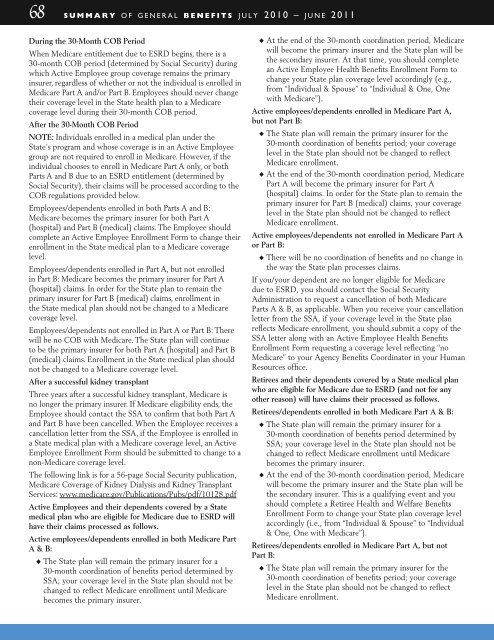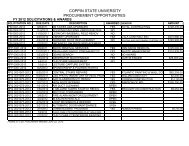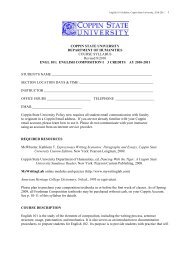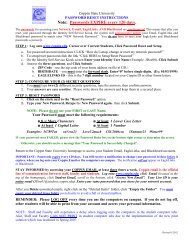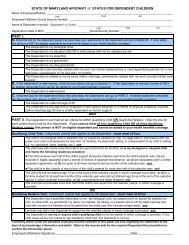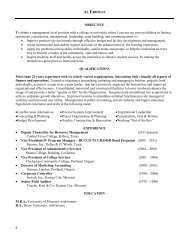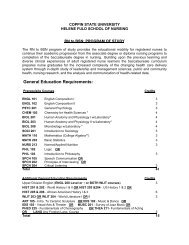FY2011 Health Benefits Booklet
FY2011 Health Benefits Booklet
FY2011 Health Benefits Booklet
You also want an ePaper? Increase the reach of your titles
YUMPU automatically turns print PDFs into web optimized ePapers that Google loves.
68 s u m m a r y o f g e n e r a l b e n e f i t s j u l y 2 0 1 0 – j u n e 2 0 1 1<br />
During the 30-Month COB Period<br />
When Medicare entitlement due to ESRD begins, there is a<br />
30-month COB period (determined by Social Security) during<br />
which Active Employee group coverage remains the primary<br />
insurer, regardless of whether or not the individual is enrolled in<br />
Medicare Part A and/or Part B. Employees should never change<br />
their coverage level in the State health plan to a Medicare<br />
coverage level during their 30-month COB period.<br />
After the 30-Month COB Period<br />
NOTE: Individuals enrolled in a medical plan under the<br />
State’s program and whose coverage is in an Active Employee<br />
group are not required to enroll in Medicare. However, if the<br />
individual chooses to enroll in Medicare Part A only, or both<br />
Parts A and B due to an ESRD entitlement (determined by<br />
Social Security), their claims will be processed according to the<br />
COB regulations provided below.<br />
Employees/dependents enrolled in both Parts A and B:<br />
Medicare becomes the primary insurer for both Part A<br />
(hospital) and Part B (medical) claims. The Employee should<br />
complete an Active Employee Enrollment Form to change their<br />
enrollment in the State medical plan to a Medicare coverage<br />
level.<br />
Employees/dependents enrolled in Part A, but not enrolled<br />
in Part B: Medicare becomes the primary insurer for Part A<br />
(hospital) claims. In order for the State plan to remain the<br />
primary insurer for Part B (medical) claims, enrollment in<br />
the State medical plan should not be changed to a Medicare<br />
coverage level.<br />
Employees/dependents not enrolled in Part A or Part B: There<br />
will be no COB with Medicare. The State plan will continue<br />
to be the primary insurer for both Part A (hospital) and Part B<br />
(medical) claims. Enrollment in the State medical plan should<br />
not be changed to a Medicare coverage level.<br />
After a successful kidney transplant<br />
Three years after a successful kidney transplant, Medicare is<br />
no longer the primary insurer. If Medicare eligibility ends, the<br />
Employee should contact the SSA to confirm that both Part A<br />
and Part B have been cancelled. When the Employee receives a<br />
cancellation letter from the SSA, if the Employee is enrolled in<br />
a State medical plan with a Medicare coverage level, an Active<br />
Employee Enrollment Form should be submitted to change to a<br />
non-Medicare coverage level.<br />
The following link is for a 56-page Social Security publication,<br />
Medicare Coverage of Kidney Dialysis and Kidney Transplant<br />
Services: www.medicare.gov/Publications/Pubs/pdf/10128.pdf<br />
Active Employees and their dependents covered by a State<br />
medical plan who are eligible for Medicare due to ESRD will<br />
have their claims processed as follows.<br />
Active employees/dependents enrolled in both Medicare Part<br />
A & B:<br />
u The State plan will remain the primary insurer for a<br />
30-month coordination of benefits period determined by<br />
SSA; your coverage level in the State plan should not be<br />
changed to reflect Medicare enrollment until Medicare<br />
becomes the primary insurer.<br />
u At the end of the 30-month coordination period, Medicare<br />
will become the primary insurer and the State plan will be<br />
the secondary insurer. At that time, you should complete<br />
an Active Employee <strong>Health</strong> <strong>Benefits</strong> Enrollment Form to<br />
change your State plan coverage level accordingly (e.g.,<br />
from “Individual & Spouse” to “Individual & One, One<br />
with Medicare”).<br />
Active employees/dependents enrolled in Medicare Part A,<br />
but not Part B:<br />
u The State plan will remain the primary insurer for the<br />
30-month coordination of benefits period; your coverage<br />
level in the State plan should not be changed to reflect<br />
Medicare enrollment.<br />
u At the end of the 30-month coordination period, Medicare<br />
Part A will become the primary insurer for Part A<br />
(hospital) claims. In order for the State plan to remain the<br />
primary insurer for Part B (medical) claims, your coverage<br />
level in the State plan should not be changed to reflect<br />
Medicare enrollment.<br />
Active employees/dependents not enrolled in Medicare Part A<br />
or Part B:<br />
u There will be no coordination of benefits and no change in<br />
the way the State plan processes claims.<br />
If you/your dependent are no longer eligible for Medicare<br />
due to ESRD, you should contact the Social Security<br />
Administration to request a cancellation of both Medicare<br />
Parts A & B, as applicable. When you receive your cancellation<br />
letter from the SSA, if your coverage level in the State plan<br />
reflects Medicare enrollment, you should submit a copy of the<br />
SSA letter along with an Active Employee <strong>Health</strong> <strong>Benefits</strong><br />
Enrollment Form requesting a coverage level reflecting “no<br />
Medicare” to your Agency <strong>Benefits</strong> Coordinator in your Human<br />
Resources office.<br />
Retirees and their dependents covered by a State medical plan<br />
who are eligible for Medicare due to ESRD (and not for any<br />
other reason) will have claims their processed as follows.<br />
Retirees/dependents enrolled in both Medicare Part A & B:<br />
u The State plan will remain the primary insurer for a<br />
30-month coordination of benefits period determined by<br />
SSA; your coverage level in the State plan should not be<br />
changed to reflect Medicare enrollment until Medicare<br />
becomes the primary insurer.<br />
u At the end of the 30-month coordination period, Medicare<br />
will become the primary insurer and the State plan will be<br />
the secondary insurer. This is a qualifying event and you<br />
should complete a Retiree <strong>Health</strong> and Welfare <strong>Benefits</strong><br />
Enrollment Form to change your State plan coverage level<br />
accordingly (i.e., from “Individual & Spouse” to “Individual<br />
& One, One with Medicare”).<br />
Retirees/dependents enrolled in Medicare Part A, but not<br />
Part B:<br />
u The State plan will remain the primary insurer for the<br />
30-month coordination of benefits period; your coverage<br />
level in the State plan should not be changed to reflect<br />
Medicare enrollment.


